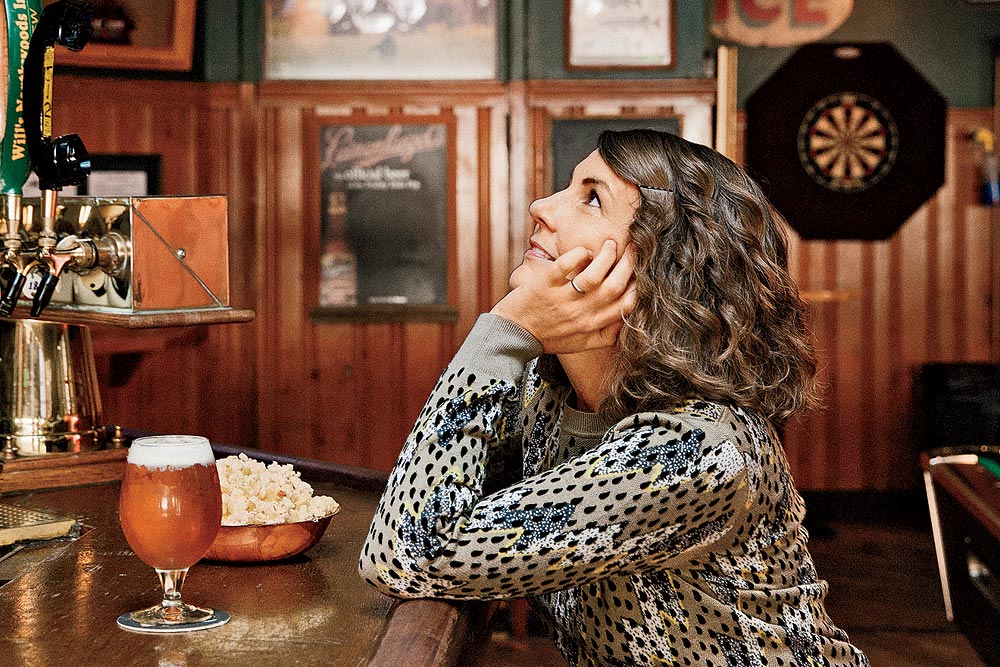Michelle Grabner has built perhaps the most encyclopedic résumé in art. When asked for the 60-second version, she has one ready: “I’m an artist who has side jobs.”
Right now all anyone wants to talk about is one job in particular: cocurating the 2014 Whitney Biennial. Not the two ad hoc galleries, the Suburban (in her Oak Park backyard) and Poor Farm (near her vacation home in rural Wisconsin), that she started with her husband, the artist and professor Brad Killam. Not the coveted invite to teach painting at Yale, her tenured professorship at the School of the Art Institute, or her criticism for Artforum. And not her paintings, which will be on display at the Museum of Contemporary Art Cleveland in a survey exhibition that opens November 1. “She has busted her ass for 20 years,” says her gallerist, Shane Campbell.
No, people want to talk about her appointment to the Whitney Biennial because it was a divergent year. For starters, three non-Whitney curators were selected: Anthony Elms, of the Institute of Contemporary Art in Philadelphia; Stuart Comer, formerly of the Tate Modern; and Grabner, who lives and paints in the Chicago suburbs, a place that is as foreign to the New York art world as Mars. Grabner, 51, is the first artist-curator of the event; as such, she rejects the traditional idea that she tap the Next Art Star. “I’m more interested in people who take on the freedoms of being off center,” she says. “I’m also thinking about teachers—the academy—and the old cliché that those who teach don’t. It is spot-on but also not. I want to look for people who influence the talent.”
That notion is clearly personal. A 17-year vet of the SAIC, Grabner presides over a diaspora of young painters. And she has deftly used the Suburban, her 15-year-old gallery in a former garden shed, to stitch together an international network of artists who show their work, stay for grilled bratwurst, and crash at her house. “She’s crafted a life outside of the center that has, in time, brought the center to her,” says David Norr, chief curator at MOCA Cleveland.
“I’ve tried to keep my experiments in the bigger art world as close to my domestic situation as possible,” Grabner explains, sipping a virgin Bloody Mary on the sunlit patio of Will’s Northwoods Inn in Lake View (no booze since she soon has to pick up her eight-year-old, the youngest of three). The native of Oshkosh, Wisconsin, says that she sometimes steals away to this taxidermy-stuffed bar to root for her beloved Packers with other dyed-in-the-green-wool fans. And the laborious craft techniques, such as silverpoint, that undergird her intricately patterned paintings—many she learned as a graduate student at Northwestern.
But she doesn’t feel any obligation to colonize her Biennial floor for the Midwest. After the Whitney announcement, she recalls, “a couple of people who are curators in Chicago claimed that now Chicago can be nicely represented. My response was—excuse my French—fuck them. Why don’t they let that influence their own curatorial decisions? I didn’t go into this thinking regionally.
“I’m midcareer,” continues Grabner, who is also juggling three solo exhibitions—in San Francisco, Basel, and New York—planned for 2014. “I can have a real stinker of a show or curate the worst Whitney Biennial to be seen, and I will soldier on. I am not paralyzed by fear or trying to overanticipate what the audience wants. I get to do what I want. That’s a great thing.”
Where to see her next: The Whitney Biennial runs March 7 to May 25 in New York City. A survey exhibition of Grabner’s paintings opens at MOCA Cleveland on Nov. 1. And Grabner will preview 'Work From Home' at Expo Chicago on Friday, September 20.




